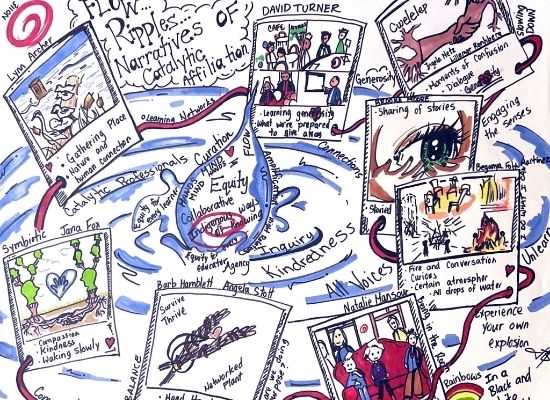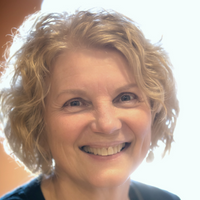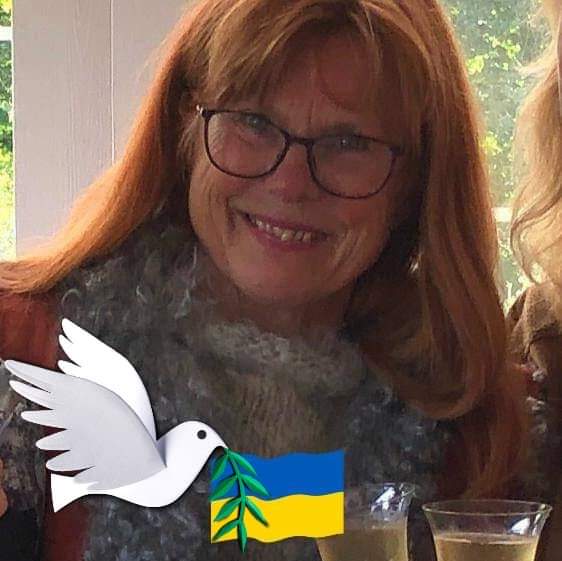Transformative Educational Leadership Program | ISSUE: Spring 2022
With her term “catalytic affiliation,” Dr Catherine McGregor captures the sparks that fly within a network. This team presentation speaks to the learning that sparked each member as an effect of their connections. As you listen to this multimedia collaboration, consider how the energy you receive from the networks you are part of can speed up change efforts and amplify impact.
Catalytic Affiliation within the Networks of Inquiry and Indigenous Education
Catalytic affiliation is a term that describes how interpersonal and professional connections in a learning network accelerate educators’ commitments to engage in equity-informed educational innovations.
Relational connections between networked members spread impacts widely and enable exponential growth between and among people as they collectively engage in professional learning and inquiry.
This type of action-oriented and collaborative learning engages hands, minds, and hearts to make a difference for all learners. Catalytic affiliation is the spark that ignites learning leaders.
We’ve studied these dynamics in diverse settings, and learned a lot about how catalytic affiliation is operationalized in school communities. In the stories that follow, you’ll see and hear more about how catalytic leaders curate activities, actions and critical engagement to promote equitable and inclusive learning opportunities.
Jody Billingsley

Jody Billingsley is an educational leader, principal, and artist in British Columbia. He enjoys using art to tell stories, bring ideas to life, and educate. Illustrating in real-time is a recent venture for Jody and his ability to draw quickly and synthesize themes into a cohesive art piece helps bring a visual component to novel educational concepts and trends.
Lynn Archer

Listen to Lynn’s Audio
View Lynn’s Text
The waterways and low-lying lands of Richmond have been a gathering place for thousands of years. Human life and wildlife came to gather food. When settlers first came it continued to be a gathering place, and it is today as Richmond is the gateway for Canada’s second largest international airport. This image taken from the dike along the Fraser River in Richmond is meaningful for me in terms of the NOIIE, as the network is a gathering place for people to share ideas, understandings, and create new possibilities. We come from different places. We don’t all look or sound the same. We have many different ideas and thoughts. Despite differences, we gather – virtually and in person – when possible, to nurture equity and innovation for all.
The log represents collaboration and having a safe and trusting place to come together for meaningful, professional learning. The birds represent all of us networking as learning leaders within the Richmond School District, and across the province and the world creating threads, sparks, and connections. The water represents inquiry and innovation as its constant flow is like the continuous curiosity and courage needed to “engage in practices of professional vulnerability” to build commitment and spread innovation. The grasses represent conditions for growth and learning to have equitable, quality learning for all.
In the hən̓q̓əmin̓əm̓ language, nə́c̓aʔmat (Nahts–su-mott) šxʷqʷeləwən (Squa-le-win) means we are of one heart and one mind. We are all on a learning journey together when it comes to reconciling what we’ve learned (or not learned) in the past with what we are coming to understand today, although we may be at different places along the way. nə́c̓aʔmat šxʷqʷeləwən (Nahts-su-mott Squa-le-win) from the gathering place
By Lynn Archer
Jana Fox

Listen to Jana's Audio
View Jana's Text
Fungi and trees have a symbiotic and reciprocal relationship, exchanging vital nutrients and gases, enabling each participant to thrive. The fungi also form an underground web of fibres connecting the roots of trees within a radius of many metres and kilometres. This web of life not only transports nutrients between plants, but it also creates a dazzling complex and collaborative network of communication and cooperation amongst the trees.
This image represents the interconnected relational and synergistic nature of NOIIE. At the centre is a hand in a heart created by Gitxsan artist Michelle Stoney. The hand reminds us to be aware of how our actions affect others. The heart represents compassion and kindness. This reminds me of the Wet’suwet’en word that translates into strong-hearted, describing courageous and compassionate leaders.
Debbie Leyton Stephens is a Ts’msyen elder and educator, leading for change in our education system, so that it honours and upholds Indigenous knowledge and ways of being. Debbie reminds educators to situate ourselves to understand and reflect on our moral purpose. We must be cognizant of our heart, mind, and hands. In our hearts, have compassion for our learners and colleagues. With our minds, be curious and open to learning, and with our hands, take actions that can make a difference for our learners. In doing so we walk slowly to maintain our relationships and assess our impacts.
Walking slowly is an intentional act of establishing and maintaining interconnectedness, relationality respect, and reciprocal relationships. NOIIE is an interconnected collective of strong hearted educators walking slowly together to learn, grow, and thrive. In this dazzling web of connection and communication, we activate our hearts, minds, and hands, as a shared way of being and to make a difference.
By Jana Fox
Barb Hamblett & Angela Stott

Listen to Barb & Angela's Audio
View Barb & Angela's Text
These twin bundles of sagebrush were harvested from the hills of Kamloops, in the Secwépemculecw. This plant has spiritual and ceremonial significance for the local Indigenous people, and we believe, aptly represents the network Angela and I have developed.
The Ecological Society of America reports that Sagebrush operate as a networked plant, communicating ways to survive and thrive in the presence of adversity. In fact, Sagebrush support each other in ways that actually influence other plants to take action.
Barb and I operate within a collective of sagebrush who, through planned and intentional action, continually strive to diversify our networks.
For instance, when Dr. McGregor’s work with the Indigenous Transitions network was shared out through the Aboriginal Enhancement Schools Network, the Transitions Report identified key strategies used by the ally-focused inquiry teams. Strategies like adjusting your risk meter, questioning your bias and privilege and making sure to connect the head, heart and hands were all emphasized. These strategies resonated deeply for me and Angela and I use them throughout our own work.
I have been privileged to have been connected to networks throughout my career. They have shaped who I am as an educator thriving on the collective brain power and action of a group. My involvement, small and large, with QTL, mentioned in Catherine McGregor’s paper; NW RISE, in their early days of realizing a network in the Pacific Northwest; the Network of Performance Based Schools that grounded me in collaborative and collective work; and the Network of Inquiry and Indigenous Education to name some, have emphasized the value of relationship and a flattened hierarchy. As our image depicts, we have open and willing hearts, surrounded by informed action and strong interpersonal relations.
Working with Angela has honed my relational leadership skills and has helped me balance this with purposeful action. With every network I encounter, be that with educators in my own school, or those across BC, I hear Angela’s voice asking me… “What are we doing on purpose to meet the needs of our learners…”
Working with Barb has highlighted the acceleration of informed action. Using foundational documents and frameworks like the Spiral of Inquiry, we are more apt to take risks, be vulnerable, and have fun publicly with our colleagues who are joining us on this learning journey.
These few examples of what we have learned from others, along with the kindred nature of our own working relationship, continues to deepen the work we are currently doing. Like the Sagebrush, our networks are influencing and supporting one another, as collectively, we continue not only to survive, but thrive in the face of adversity.
By Barb Hamblett & Angela Stott
Natalie Mansour

Listen to Natalie's Audio
View Natalie's Text
Being in the room tells people that they and what they are doing is important. Prior to COVID, being in the room meant literally being in the room, driving to various meetings, sitting in spiral sessions, and even traveling overseas to sit amongst like-minded educators. Zoom has enabled us just like today to be in the room. COVID provided an opportunity to eliminate distance and ensure connections could be maintained.
The image on the screen was taken in Marrakech at ICSEI 2020. While the picture does not depict all of the people that are presenting today, it is a picture that represents the concept of catalytic affiliation. Without Judy and Linda, I would never have met and had the opportunity to learn from any of these amazing people. People who share the same moral imperative as I do. Language, distance, and politics are no barriers. I just want to take a moment to drill a little further down into what being in the room actually means. It is important that when we are in the room physically or virtually, that we are mentally there as well. It is important that we are present in the moment, in the learning.
I remember watching Judy and Linda at one of the first NOIIE symposiums I attended in Vancouver. They were front and centre, taking notes, nodding their heads, applauding. They were taking in every minute and every word. I remember thinking, I want to be just like them. I carry this learning with me everywhere in all professional learning sessions, meetings, and conversations. As a Principal, my biggest asset is my staff. And as such I need to make every learning session we have count. When I am participating in spirals, I am not on my phone, my laptop, or constantly in and out of the room. I am seeking to understand, to be a co-learner, to be a better educator, I am in the room wholeheartedly.
As a group of international educators, we each bring a perspective, or if you will, a colour. When we come together we create something beautiful, just like a rainbow. The network has made me a better educator, leader, and person, while helping create rainbows in what can sometimes be a black and white world.
By Natalie Mansour
Begonya Folch Martinez

Listen to Begonya's Audio
View Begonya's Text
As you can see, my metaphor is about FIRE & CONVERSATION.
I’ve selected 5 pieces of artwork for the things I’ve learned during these 5 years, since I met Linda & Judy for the first time.
The campfires on the right talk about light and warmth — the light of expertise and the warmth of belonging. Both paintings let colour and contrast suggest the atmosphere. I’ve learned that it takes a certain atmosphere to learn, and how important it is to create it.
But the “Hanging Fire” on the left, by Cornelia Parker, talks about something different. Teaching is an art: the work is never finished, and you need to stay curious and creative.
These chairs and headphones in a circle, by the Canadian artist Rebecca Belmore, is called “A Gathering of People for Any Purpose”, and for me is the metaphor of the conversation within the NOIIE, where all voices, cultures, and perspectives are heard. On one of these headphones, we can hear a bird-song. Even a bird can speak to remind us, like the famous hummingbird, that “all drops of water matter”: I’ve learned that “I do what I can” is a superpower.
And finally, you see below “Cold Dark Matter. An Exploded View” by Cornelia Parker.
When I read “The Spiral of Inquiry Playbook” for the first time, everything blew up, in a good sense, it was like this sight of an explosion.
The experience is individual, but the reflection is joint: interpreting the shadows and having an overall picture, we can only do it TOGETHER.
By Begonya Folch Martinez
Brooke Moore

Listen to Brooke's Audio
View Brooke's Text
From my network colleagues, I have learned the importance of engaging the senses as a way of engaging with the Spiral of Inquiry.
From my colleagues in New Zealand, who made a board-game-like protocol and set of manipulatives for moving through the Spiral of Inquiry, I learned the power of helping people engage with a theoretical process in a way they could see and touch.
From my colleagues in Australia, I learned the power of starting meetings with a short video of a learner – a powerful way of engaging the senses because in addition to moving the hearts of all the educators in the room and reminding us of the why behind our work, it shows how the individual lives in the universal – how focusing on one child can help us better see all children.
From my colleagues in England, I learned that making the micro-moves within the Spiral visual and concrete increases the accessibility of the work – graphic organizers and protocols offer those engaging in the Spiral a place for their thinking.
From my Catalan colleagues, I learned that all of this works better if it is also beautiful and storied. Moments enriched with metaphor, colour, and light resonate at a different, an embodied vibration.
My network colleagues have shown me how engaging with the senses helps us embody this work and come to it with our whole selves, that this is head, heart, and hand work.
Often this learning comes not in seminars or lectures, but in the sharing of stories, the stories of our learners, the stories of our curiosities, the stories of what matters most.
By Brooke Moore
Ingela Netz & Lillemor Rehnberg

Listen to Ingela & Lillemor's Audio
View Ingela & Lillemor's Text
Thanks to the generous community among Spiral networks around the world we have learned a lot. What we would like to mention today is the concept of cwelelep, a Líl̓wat word that over and over again reminds us about the importance to slow down while moving forward in order to avoid running away from moments of confusion where deep learning actually can happen. It doesn’t matter if it concerns our own work or if it’s in contact with the schools and school leaders we are meeting.
We are part of a system where the pressure is high on quick acting, easy quality-measuring and increasing results. In moments of confusion, of “not-knowing-yet”, it’s very tempting to quickly catch the first opportunity or solution in sight, and move on.
In being a part of the generous community of the Spiral of Inquiry where sharing, dialogues and collegial meetings are frequent, we have found the strength and generosity that gives us the courage to slow down and hold on long enough to put our hunches at the table and give them both a second and third thought together with colleagues.
In the networking community as well as in collegial, horizontal inquiry lies the power, generosity and benevolence that helps us stay in cwelelep long enough to really learn.
By Ingela Netz & Lillemor Rehnberg











